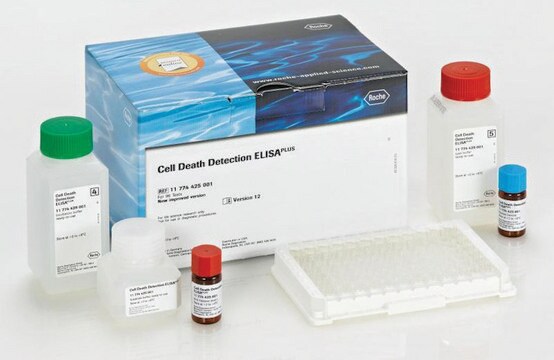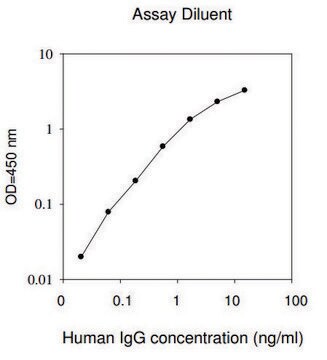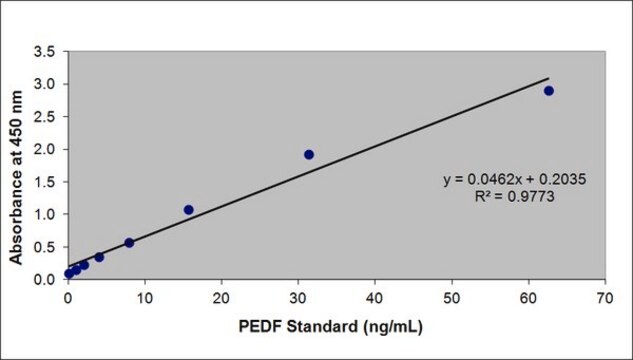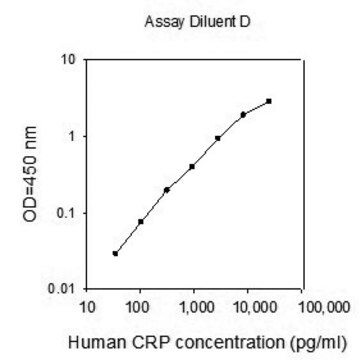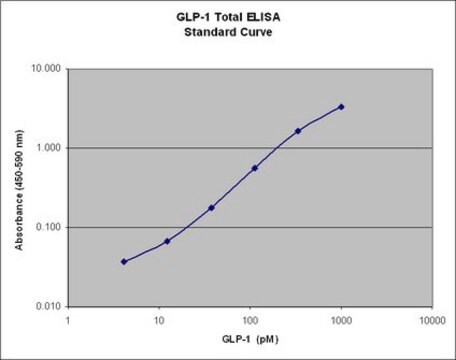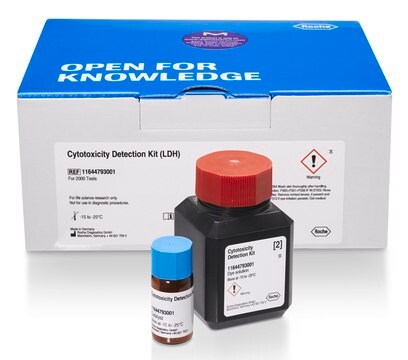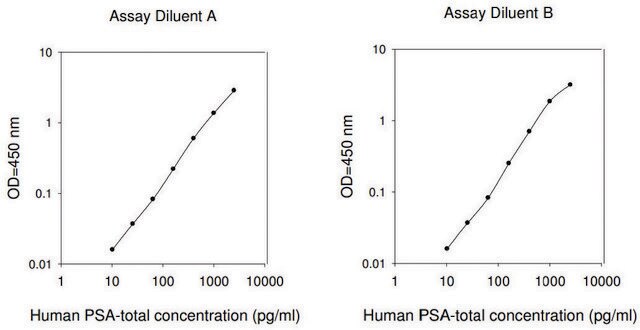おすすめの製品
アッセイ
>98% (SDS-PAGE)
使用法
sufficient for 192 tests
包装
kit of 1
メーカー/製品名
Roche
テクニック
ELISA: suitable
保管温度
2-8°C
詳細
hGHアッセイシステムは、一般的に使用されるその他ほとんどのレポーターたんぱく質(CAT、β-Gal、またはルシフェラーゼ)と、1つの重要な点で異なります。hGHは培地上清の試料を使用して測定する分泌たんぱく質であるため、(i) 細胞を溶解する必要がなく、(ii) 一過性発現動力学の継続的なモニタリングを可能にし、(iii) 細胞を他の目的(RNA分離など)に使用できるようにします。さらに、hGHは、ほとんどの哺乳類細胞におけるhGH mRNAの見かけの高い安定性に寄与する可能性がある哺乳類の遺伝子です。
標準同位体プロトコールを使用すると、細胞の種類と使用するアッセイの感度に応じて、培養液上清へのhGHたんぱく質の分泌をトランスフェクション後約24時間にわたって監視できます。通常、hGHは免疫放射定量測定法(IRMA)によって定量化され、約0.1~50 ng hGH/mlの直線範囲が得られます。
標準同位体プロトコールを使用すると、細胞の種類と使用するアッセイの感度に応じて、培養液上清へのhGHたんぱく質の分泌をトランスフェクション後約24時間にわたって監視できます。通常、hGHは免疫放射定量測定法(IRMA)によって定量化され、約0.1~50 ng hGH/mlの直線範囲が得られます。
ヒト成長ホルモン(hGH)は、hGH ELISAによって特異的に検出されます。ラット成長ホルモンとは交差反応しません。ヒトホモログTSH、FSH、およびLHとの交差反応性は、試験されていません。大腸菌由来のhGHたんぱく質は、標準検量線を編集するためにキットに含まれており、イムノアッセイで決定されたロット固有の含量データとともに提供されます。
hGH規格
大腸菌由来のhGHたんぱく質は、標準検量線を編集するためにキットに含まれており、イムノアッセイで決定されたロット固有の含量データとともに提供されます。
hGH規格
大腸菌由来のhGHたんぱく質は、標準検量線を編集するためにキットに含まれており、イムノアッセイで決定されたロット固有の含量データとともに提供されます。
特異性
hGH ELISAは、特にヒト成長ホルモン(hGH)を検出します。ラット成長ホルモンとは交差反応しません。
アプリケーション
研究用途専用。診断手順には使用しません。
hGH ELISAは、hGHをコードするレポーター遺伝子を含むプラスミドでトランスフェクトした真核細胞の細胞培養上清に放出された、hGHの発現レベルを定量的に測定するのに使用されます。
hGH ELISAは、hGHをコードするレポーター遺伝子を含むプラスミドでトランスフェクトした真核細胞の細胞培養上清に放出された、hGHの発現レベルを定量的に測定するのに使用されます。
特徴および利点
- 標準化:異なる生産ロット由来のキットを使用する場合でも、異なる実験セットのデータを直接比較可能
- 高感度化:hGH ELISAは同位体hGHアッセイより約20倍高感度
- 特異化:hGH ELISAはラット成長ホルモンとの交差反応性を示さない。
- 高速化:トランスフェクション後、早ければ18時間でhGH発現を測定し、開始から終了まで約4時間しか要さない。
- 簡単に実行:標準的なELISAプロトコールに従う。
包装
1つのキットに9つの構成要素が含まれます。
規格
アッセイ時間:約4時間
試料材料:培養上清
感度:≥5 pg/ml(≥1 pg/ウェル)
標準:標準検量線を作成するためにキットに含まれた大腸菌由来のhGHたんぱく質が、イムノアッセイで決定されたロット固有の含量データとともに提供されます。
試料材料:培養上清
感度:≥5 pg/ml(≥1 pg/ウェル)
標準:標準検量線を作成するためにキットに含まれた大腸菌由来のhGHたんぱく質が、イムノアッセイで決定されたロット固有の含量データとともに提供されます。
原理
hGH ELISAは、サンドイッチELISAの原理に基づいています。hGHに対する抗体(抗hGH)は、マイクロプレートの表面にあらかじめ結合されています。分泌されたhGHを含む培養上清をマイクロプレートモジュールのウェルに加えます。培地に含まれるhGHは、マイクロプレート表面に結合した抗hGHにすべて結合します。次に、hGHに対するジゴキシゲニン標識抗体(抗hGH-DIG)を加え、hGHに結合します。以下のステップでは、ペルオキシダーゼに共役したジゴキシゲニンに対する抗体(抗DIG-POD)を加え、ジゴキシゲニンに結合します。最終ステップで、ペルオキシダーゼ担体ABTSを加えます。ペルオキシダーゼ酵素は担体の開裂を触媒し、有色の反応生成物を生成します。試料の吸光度はELISAリーダーを使用して決定します。試料の吸光度は、培地上清に存在するhGHのレベルと直接相関しています。アッセイの感度は、ペルオキシダーゼ担体(ABTS)と担体エンハンサーを使用して向上させることができます。
調製ノート
Working solution: Solution 1 hGH Stock Solution (bottle 1)
Reconstitute the lyophilizate in 0.5 ml double distilled water. The resulting concentration is calculated using the lot-specific information, given on the label (final conc. approx 10 ng/ml). This solution is used for the preparation of hGH standards for establishing a hGH calibration curve (see 7.2: preparation of hGH standards).
Solution 2 Anti-hGH-DIG (bottle 2)
Reconstitute the lyophilizate in 0.5 ml double distilled water (final conc. 100 μg/ml).
Solution 2a Anti-hGH-DIG, working dilution
To prepare anti-hGH-DIG working dilution, dilute the reconstituted anti-hGH-DIG solution (100 g/ml) with sample buffer (solution 7) to a final conc. of 1 μg/ml (e.g., 100 μl of reconstituted anti-hGH-DIG solution 9.9 ml of solution 7 for 50 wells).The working dilution should be prepared freshly before use and should not be stored.
Solution 3 Anti-DIG-POD (bottle 3)
Reconstitute the lyophilizate in 0.5 ml double distilledwater (final conc. 20 U/ml). Do not add sodiumazide!
Solution 3a Anti-DIG-POD, working dilution
To prepare anti-DIG-POD, working dilution, dilute the reconstituted anti-DIG-POD solution (20 U/ml) with sample buffer (solution 7) to a final conc. of 200 mU/ml (e.g., 100 μl of reconstituted anti-DIG-POD solution 9.9 ml of solution 7 for 50 wells). The working dilution should be prepared freshly before use and should not be stored.
Solution 4 POD Substrate (bottle 4)
Ready-to-use solution.
Solution 5 POD Substrate containing Substrate Enhancer (bottles 4 and 5)
If a low hGH concentration in the sample is expected, add 1 mg of substrate enhancer (bottle 5) per ml of solution 4 and mix by stirring for 30 min at 15 to 25 °C. The solution is stable for only 2 hours and should therefore be prepared immediately before use. Use the substrate enhancer only if the hGH concentration is low!
Solution 6 Washing Buffer, 1× (bottle 6)
To prepare a ready-to-use washing buffer, mix 1 part 10x washing buffer concentrate (bottle 6) with 9 parts of double distilled water.
Solution 7 Sample Buffer (bottle 7)
The solution is ready-to-use. Mix thoroughly before use. Do not add sodium azide.
Storage conditions (working solution): Solution 1 hGH Stock Solution (bottle 1)
The reconstitutedsolution is stable for 2 months at 2 to 8 °C. For long term storage, store in aliquots at or below -15 to -25 °C.
Solution 2 Anti-hGH-DIG (bottle 2)
The reconstituted solution is stable for two months at 2 to 8 °C. For long term storage, store in aliquots at or below -15 to -25 °C.
Solution 2a Anti-hGH-DIG, working dilution
The working dilution should be prepared freshly before use and should not be stored.
Solution 3 Anti-DIG-POD (bottle 3)
The reconstituted solution is stable for 6 months at 2 to 8 °C. Do not freeze!
Solution 3a Anti-DIG-POD, working dilution
The working dilution should be prepared freshly before use and should not be stored.
Solution 4 POD Substrate (bottle 4)
The solution is stable until the expiration date given on the label if stored at 2 to 8 °C.
POD Substrate containing Substrate Enhancer (bottles 4 and 5)
The solution is stable for only 2 hours and should therefore be prepared immediately before use.
Solution 6 Washing Buffer, 1× (bottle 6)
The reconstituted solution is stable for 6 months at 2 to 8 °C.
Solution 7 Sample Buffer (bottle 7)
After opening the bottle we recommend storing the solution in aliquots at -15 to -25 °C, since it does not contain a preservative agent.
Reconstitute the lyophilizate in 0.5 ml double distilled water. The resulting concentration is calculated using the lot-specific information, given on the label (final conc. approx 10 ng/ml). This solution is used for the preparation of hGH standards for establishing a hGH calibration curve (see 7.2: preparation of hGH standards).
Solution 2 Anti-hGH-DIG (bottle 2)
Reconstitute the lyophilizate in 0.5 ml double distilled water (final conc. 100 μg/ml).
Solution 2a Anti-hGH-DIG, working dilution
To prepare anti-hGH-DIG working dilution, dilute the reconstituted anti-hGH-DIG solution (100 g/ml) with sample buffer (solution 7) to a final conc. of 1 μg/ml (e.g., 100 μl of reconstituted anti-hGH-DIG solution 9.9 ml of solution 7 for 50 wells).The working dilution should be prepared freshly before use and should not be stored.
Solution 3 Anti-DIG-POD (bottle 3)
Reconstitute the lyophilizate in 0.5 ml double distilledwater (final conc. 20 U/ml). Do not add sodiumazide!
Solution 3a Anti-DIG-POD, working dilution
To prepare anti-DIG-POD, working dilution, dilute the reconstituted anti-DIG-POD solution (20 U/ml) with sample buffer (solution 7) to a final conc. of 200 mU/ml (e.g., 100 μl of reconstituted anti-DIG-POD solution 9.9 ml of solution 7 for 50 wells). The working dilution should be prepared freshly before use and should not be stored.
Solution 4 POD Substrate (bottle 4)
Ready-to-use solution.
Solution 5 POD Substrate containing Substrate Enhancer (bottles 4 and 5)
If a low hGH concentration in the sample is expected, add 1 mg of substrate enhancer (bottle 5) per ml of solution 4 and mix by stirring for 30 min at 15 to 25 °C. The solution is stable for only 2 hours and should therefore be prepared immediately before use. Use the substrate enhancer only if the hGH concentration is low!
Solution 6 Washing Buffer, 1× (bottle 6)
To prepare a ready-to-use washing buffer, mix 1 part 10x washing buffer concentrate (bottle 6) with 9 parts of double distilled water.
Solution 7 Sample Buffer (bottle 7)
The solution is ready-to-use. Mix thoroughly before use. Do not add sodium azide.
Storage conditions (working solution): Solution 1 hGH Stock Solution (bottle 1)
The reconstitutedsolution is stable for 2 months at 2 to 8 °C. For long term storage, store in aliquots at or below -15 to -25 °C.
Solution 2 Anti-hGH-DIG (bottle 2)
The reconstituted solution is stable for two months at 2 to 8 °C. For long term storage, store in aliquots at or below -15 to -25 °C.
Solution 2a Anti-hGH-DIG, working dilution
The working dilution should be prepared freshly before use and should not be stored.
Solution 3 Anti-DIG-POD (bottle 3)
The reconstituted solution is stable for 6 months at 2 to 8 °C. Do not freeze!
Solution 3a Anti-DIG-POD, working dilution
The working dilution should be prepared freshly before use and should not be stored.
Solution 4 POD Substrate (bottle 4)
The solution is stable until the expiration date given on the label if stored at 2 to 8 °C.
POD Substrate containing Substrate Enhancer (bottles 4 and 5)
The solution is stable for only 2 hours and should therefore be prepared immediately before use.
Solution 6 Washing Buffer, 1× (bottle 6)
The reconstituted solution is stable for 6 months at 2 to 8 °C.
Solution 7 Sample Buffer (bottle 7)
After opening the bottle we recommend storing the solution in aliquots at -15 to -25 °C, since it does not contain a preservative agent.
アナリシスノート
ラット成長ホルモンとは交差反応しません。ヒトホモログTSH、FSH、およびLHとの交差反応性は試験されていません。
その他情報
生命科学研究専用。診断手順には使用しません。
キットの構成要素のみ
製品番号
詳細
- hGH (human growth hormone)
- Anti-hGH-digoxigenin (anti-hGH-DIG) antibody, lyophilizate
- Anti-Digoxigenin-POD antibody, lyophilizate
- POD Substrate ready-to-use
- Substrate Enhancer
- Washing Buffer 10x concentrated
- Sample Buffer
- Microplates (24x8 wells), precoated with anti-hGH (2)
- Self-adhesive Plate Cover Foils (6)
すべて表示 (9)
シグナルワード
Warning
危険有害性情報
危険有害性の分類
Aquatic Chronic 3 - Eye Irrit. 2 - Skin Sens. 1
保管分類コード
12 - Non Combustible Liquids
WGK
WGK 3
引火点(°F)
does not flash
引火点(℃)
does not flash
Jessica R Chaffey et al.
Scientific reports, 11(1), 15624-15624 (2021-08-04)
The generation of a human pancreatic beta cell line which reproduces the responses seen in primary beta cells, but is amenable to propagation in culture, has long been an important goal in diabetes research. This is particularly true for studies
Gabriela da Silva Xavier et al.
The Biochemical journal, 371(Pt 3), 761-774 (2003-02-19)
AMP-activated protein kinase (AMPK) has recently been implicated in the control of preproinsulin gene expression in pancreatic islet beta-cells [da Silva Xavier, Leclerc, Salt, Doiron, Hardie, Kahn and Rutter (2000) Proc. Natl. Acad. Sci. U.S.A. 97, 4023-4028]. Using pharmacological and
Woo-Jae Park et al.
Neuroscience letters, 444(3), 240-244 (2008-09-02)
Leucine-rich glioma inactivated 3 (LGI3) is a member of LGI/epitempin (EPTP) family. The biological function of LGI3 and its association with disease are not known. We previously reported that mouse LGI3 was highly expressed in brain in a developmentally and
ライフサイエンス、有機合成、材料科学、クロマトグラフィー、分析など、あらゆる分野の研究に経験のあるメンバーがおります。.
製品に関するお問い合わせはこちら(テクニカルサービス)